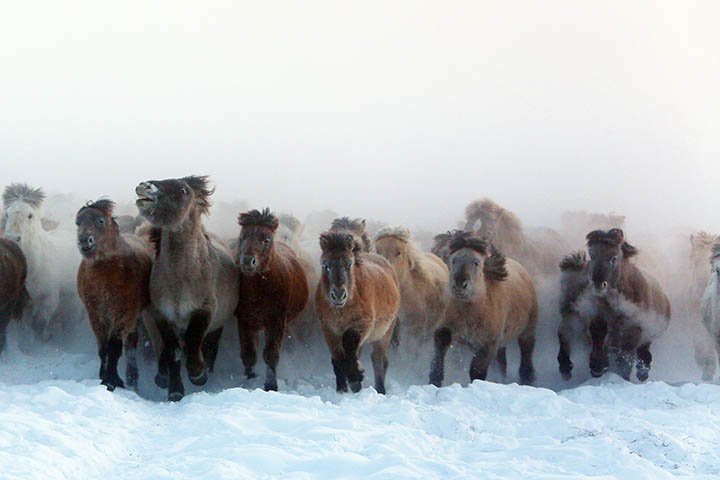
‘We managed to get samples of this unique find for biotechnology research.’ Picture: Michil Yakovlev/SVFU
By The Siberian Times
Plan for surrogate mare to give birth and bring back to life long-gone species in Russia’s coldest region.
A search is now underway in Yakutsk for live cells from a foal found in the permafrost as our pictures show.
The joint bid is being made by Russian and South Korean scientists who are also collaborating on recreating the woolly mammoth.
The frozen carcass of the dark-brown baby horse is from an extinct species is up to 40,000 years old, and the animal was perfectly preserved in the Siberian permafrost in the Batagai crater in Yakutia, the coldest region in Russia.
Leading researcher of the laboratory of Mammoth Museum Dr Semyon Grigoriev said: ‘Fortunately, the animal’s muscle tissues were undamaged and well preserved, so we managed to get samples of this unique find for biotechnology research.’
South Korean cloning expert Professor Hwang Woo Suk, currently in Yakutsk, told The Siberian Times that a joint bid is underway to find a living cell for the possible cloning of the foal.
‘If we manage to find a cell, then we will do our best to clone the unique animal,’ he said. ‘We are trying to make a primary culture using this baby horse, which was discovered a few weeks ago. ‘If we get live cells from this ancient baby horse, it is a wonderful promise to people in terms of cloning.’ When the woolly mammoth makes a comeback, its surrogate mother will be an elephant – but he said it should be easier to use a modern-day mare to restore a lost horse species.
‘We have so many live horses,’ he said. ‘We can get a very good choice of eggs from these female horses. ‘And after making the cloned embryo with this baby horse, we can easily transport it to the surrogate mother. ‘There are the types of horses that are very close with the ancient one.’
In contrast, there is ‘a very big distance between the ancient mammoth and the elephant’, he said. ‘There are a million years of evolution between them.’ He stressed: ‘So if we find only one live cell, we can clone this ancient horse. ‘If we have one live cell, we can multiply it and get as many embryos as we need.
‘Actually if we get the living cell from the ancient tissue it will be unique by itself, because no one managed to do this before.
‘And if we manage to clone the horse – it will be the first step to cloning the mammoth.
‘It will help us to work out the technology.’

The frozen carcass of the dark-brown baby horse is from an extinct species is up to 40,000 years old. Pictures: Michil Yakovlev/SVFU
He announced that a top researcher from his team will stay in Siberia and work with scientists at the North Eastern Federal University.
‘One of the best researchers from my team, Miss Hae Hyun Kim, will stay in Yakutsk for a while to try to get a primary culture using our method and our patented NT-1 technology which helps to improve the cell, to repair it,’ he said.
‘Miss Kim for the first time managed to take the live cell from the frozen tissue. ‘It is very difficult, because water crystallises in the cell and destroys it. ‘But she managed previously to take a cell from the frozen tissue.’
This was in the case of a pet dog that an owner had put into his freezer. ‘We produced the cell successfully even from this frozen body,’ said the professor. ‘We brought with us all materials needed (to do the same with the foal).
‘My team and Dr Grigorev will collaborate and try to get live cells.’

Researcher Hae Hyun Kim will try to get the living cell from the ancient horse.
Cell culture refers to the removal of cells from the animal and their subsequent growth in an artificial environment. Primary culture refers to the stage after the cells are isolated from the tissue and proliferated under the appropriate conditions until they occupy all the available substrate. The foal was dug from its icy grave in the Batagai depression or crater last month.
The discovery came during searches for preserved remains of woolly mammoths in Yakutia, also called Sakha Republic. Earlier Dr Grigoriev said: ‘The foal has no damage to its carcass, even its hair is preserved – which is incredibly rare for such ancient finds.’
Its mane and tail are intact.
The foal was male and around 20 days old when it died. Its overall colouring was light ginger. After tens of thousands of years of dirt was washed off, the mane and tail were black – with a dark stripe along the spine.



